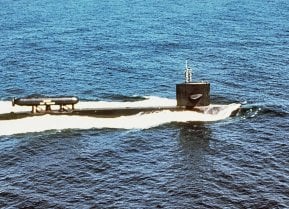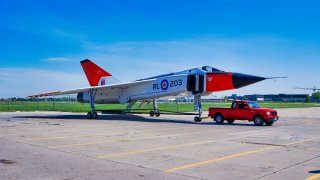Avro Canada CF-105 “Arrow”: Built to Fighter Russia (And Never Flew)
The Avro Canada CF-105 Arrow was a groundbreaking Cold War fighter jet developed to protect Canada from Soviet bombers. With a fly-by-wire system and powerful Iroquois engines, it boasted Mach-2 speeds and advanced technology ahead of its time. However, despite its innovations, the program became too costly, exceeding $1.58 billion (in today’s dollars).
What You Need to Know: The Avro Canada CF-105 Arrow was a groundbreaking Cold War fighter jet developed to protect Canada from Soviet bombers. With a fly-by-wire system and powerful Iroquois engines, it boasted Mach-2 speeds and advanced technology ahead of its time. However, despite its innovations, the program became too costly, exceeding $1.58 billion (in today’s dollars).

-On "Black Friday" in 1959, Canadian Prime Minister John Diefenbaker abruptly canceled the project, leaving 14,500 unemployed.
-The Arrow's cancellation ended Avro Canada and dashed the nation's aerospace ambitions, but its legacy remains a symbol of Canadian engineering ingenuity.
The Avro CF-105 Arrow: Canada’s Lost Cold War Fighter
The Avro Canada CF-105 “Arrow” was one of the best Cold War fighters you probably never heard of.
Was it the ace Canada never played against the Soviet Union?
The airplane’s manufacturer raced onto the scene at a time when the British defense industry was struggling. Avro Canada stepped in to fill that void. It produced an all-weather air superiority interceptor to protect against Soviet bombers.
The fighter had an early and innovative fly-by-wire system and computerized controls that were ahead of its time.
CF-105 and Canada’s Soaring Ambitions
Avro Canada was an aerospace firm founded in 1945. It built the first Canadian passenger jet and the CF-100 Canuck – the first all-Canadian fighter jet – on its way to becoming one of the largest companies in Canada. After the Royal Canadian Air Force in 1952 established the specs it wanted in a better fighter, the Canadian government in 1954 went to Avro to build a new supersonic warplane.

That plane would become the CF-105 Arrow. Avro submitted several delta-wing designs to the air force. The government wanted the most advanced airplane possible – it wanted to outclass anything flown around the world. Chief Engineer Jim Floyd said, “What the air staff were asking for was the moon.”
The designers and engineers built a scale model and ran it through an exorbitant amount of wind tunnel testing and other free-flight evaluations. The Canadians had to produce their own parts with production tooling. They produced a full-scale metal mockup, including a model of the cockpit that they tested using a truck.
Then the designers and engineers configured the fly-by-wire system.
Sister company Orenda Engines knew that they needed a special power plant, one that did not exist at the time. This meant that designers were putting together a new airplane and an engine at the very same time – a difficult set of tasks that also assumed both projects would come in on time and under budget. The new engine was named the Iroquois, and it pushed out 23,450 pounds of thrust. Two after-burning Iroquois engines were installed.
In 1957, the CF-105 Arrow was unveiled to 14,000 people in Toronto. It all came together in 1958, when the CF-105 Arrow made its first flight.
The Arrow was heavy at 28 tons. The delta-shaped wingspan was 50 feet, and the overall length was 85.5 feet – about a third longer and wider than the Eurofighter Typhoon.
It had a maximum speed of 1,524 miles per hour (Mach-2), with a 4 minute, 24 second rate of climb to reach 50,000 feet. Its ceiling was 58,500 feet. The CF-105 was a two seater.
The CF-105 Burned Through the Skies and the Wallet
Unfortunately, the design and testing stage of the CF-105 had burned through more than $1.58 billion dollars in today’s money. The Canadian government knew that they would have to pump in more resources to bring the airplane to serial production, and Prime Minister John Diefenbaker was not ready to make that kind of commitment. Without warning, on what was called Black Friday, Feb. 20, 1959, he made the decision to cancel the CF-105 program.
This left 14,500 people suddenly unemployed. The workers and the public could not believe what happened. Many of the best engineers left for the United States, where they would work on the Mercury, Gemini, and Apollo space programs.
The remaining prototypes were scrapped. Avro as a company also eventually shut down, and 50,000 people lost their jobs.
It was a disappointing time for Canadian industry. The designers were hardworking and innovative. The airplane looked great and was a testament to Canadian ingenuity. The costs for such a small country, however, were just too high. The difficult decision to ax the program left many wondering what could have been for such an advanced airplane.
Some of the components of the fighter still survive and are located at the Canada Aviation and Space Museum in Ottawa, Ontario.
About the Author
Dr. Brent M. Eastwood is the author of Humans, Machines, and Data: Future Trends in Warfare. He is an Emerging Threats expert and former U.S. Army Infantry officer. You can follow him on Twitter @BMEastwood. He holds a Ph.D. in Political Science and Foreign Policy/ International Relations.
Image Credit: Creative Commons.


